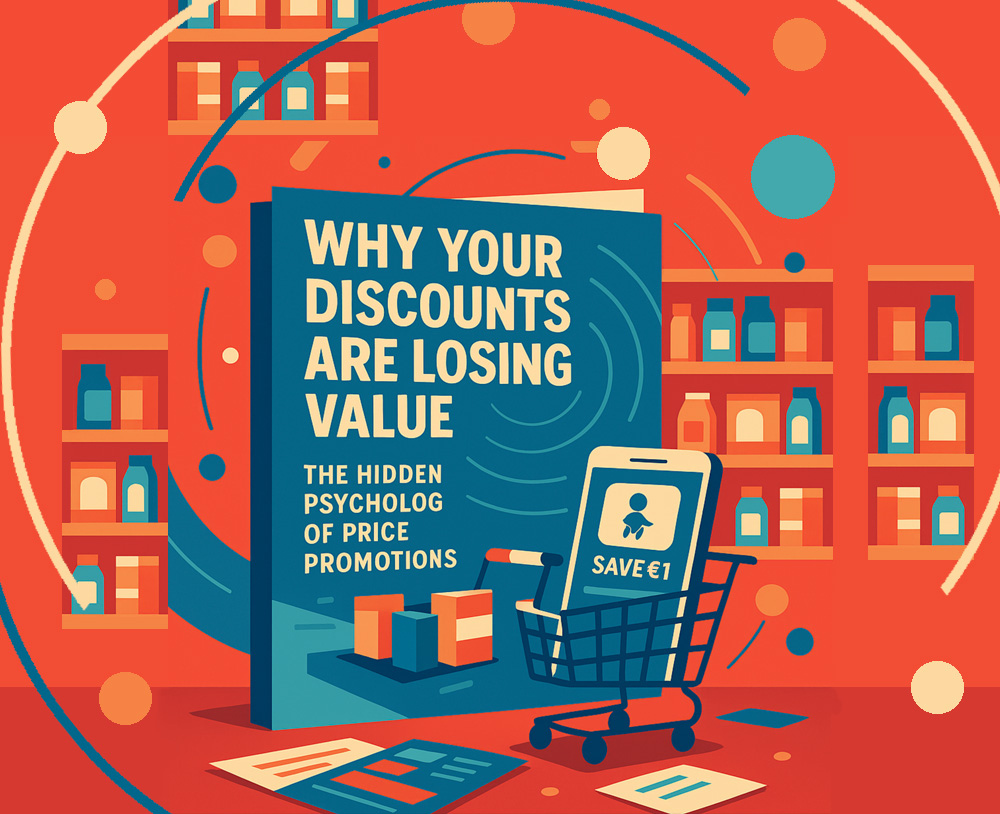
Article info
Springer: Quantitative Marketing and Economics (2023) volume 21, pages 147–181
Price promotions, beneficiary framing, and mental accounting
Authors: Geoffrey Fisher · Matthew McGranaghan· Jura Liaukonyte · Kenneth C. Wilbur
Article history: Published online: 10 March 2023
https://doi.org/10.1007/s11129-023-09261-0
Retailers and brands have long relied on price promotions—discounts, coupons, and limited-time offers—to entice consumers and boost sales. However, not all promotions are created equal. A recent study by Geoffrey Fisher, Matthew McGranaghan, Jura Liaukonyte, and Kenneth C. Wilbur, delves into a fascinating psychological phenomenon: beneficiary framing. This research reveals that how a promotion is worded can influence consumer behaviour just as much as—if not more than—the discount itself.
The study, conducted through two large-scale field experiments with over 73,000 participants and eight additional controlled studies, shows that when a savings message is framed as benefiting a specific recipient (such as a child), consumers are significantly more likely to engage with the offer. This effect, researchers found, can be equivalent by adding an extra five cents to the coupon value—a small but meaningful shift in consumer perception that can have significant financial implications for brands.
But there’s more to this story. The study also explores the shifting landscape of promotions, revealing an overlooked consequence: companies may be losing value in their promotional strategies due to changing consumer psychology and evolving market conditions.
Why Do Consumers Respond Differently to Framing?
At the heart of the study is the concept of mental accounting, a behavioural finance theory that suggests consumers don’t view all money as the same. Instead, they mentally allocate funds into different “accounts”—for instance, groceries, entertainment, or baby products. When a price promotion explicitly references a category where a consumer has a mental budget (such as “Save for your baby”), it reinforces the relevance of the discount and makes it feel more valuable.
In simple terms, a coupon framed as “Save $1.00” might be seen as a general discount, but a coupon that says “Save $1.00 for your baby” connects more deeply with parents who have mentally earmarked money for their child’s needs. The latter framing makes the coupon feel more “account-relevant,” increasing the likelihood that the consumer will print and redeem it.
This effect is particularly strong in categories where consumers already practice budget segmentation. The study found that when consumers had a mental account for baby-related expenses, a “baby-focused” discount was rated as more valuable than an equivalent general discount. This means marketers can tap into existing consumer budgeting habits to drive engagement—without increasing actual promotional spending.
The Changing Economics of Promotions: Are Companies Losing Value?
Promotions have always been a tricky balancing act. While discounts attract consumers, they also carry risks: profit erosion, brand devaluation, and consumer reliance on deals. The study highlights an important shift in promotional effectiveness—traditional one-size-fits-all discounts may be losing their impact as consumers become more selective and psychologically attuned to deal structures.
This shift is not just academic. Many brands are unknowingly sacrificing potential revenue by failing to optimize their promotional language. The study quantifies this in an unexpected way: the impact of beneficiary framing on consumer engagement is equivalent to increasing the coupon value by approximately 3.4%. That means brands that aren’t using beneficiary framing could be losing out on a significant engagement boost—essentially leaving money on the table.
Furthermore, the researchers found that promotional effectiveness is context-dependent. While beneficiary framing generally increases engagement, it has a boundary condition: if the recipient doesn’t identify with the suggested beneficiary (for example, if they don’t have children), it can actually decrease their likelihood of using the offer. This suggests that hyper-targeted promotions, rather than broad, one-size-fits-all discounts, may be the future of effective promotional strategies.
What This Means for Marketers
The findings from this study offer a practical, low-cost solution for brands looking to improve their promotional effectiveness without necessarily increasing discount amounts. Here are the key messages:
- Use Beneficiary Framing to Enhance Perceived Value
Instead of offering a generic “Save $5” discount, tailor the message to a relevant spending category. For example:- “Save $5 for Your Family” (for household products)
- “Save $10 for Your Next Adventure” (for travel deals)
- “Save $3 for Your Pet” (for pet-related items)
By aligning the promotion with consumers’ mental budgeting habits, brands can make discounts feel more compelling.
- Understand the Risks of Over-Promotion
The research suggests that companies should rethink how they structure promotions. If a discount isn’t framed effectively, it could be losing value—essentially giving away margins without maximizing consumer response. - Targeted Promotions Matter More Than Ever
Not every consumer will respond positively to every framed message. Brands need to ensure that the right promotions reach the right audience. This means leveraging customer data to tailor promotions effectively—whether through digital coupons, email marketing, or in-app offers. - The Future of Promotions is Psychological, Not Just Financial
Price reductions alone are not enough to drive engagement. In an increasingly competitive market, brands need to go beyond the numbers and tap into the psychology of decision-making. Beneficiary framing is just one example of how subtle tweaks in messaging can yield significant returns.
Conclusion: The Hidden Cost of Ignoring Consumer Psychology
The research reveals that traditional promotional strategies may be failing to fully capture consumer attention—and, in some cases, may even be backfiring. In a world where marketing budgets are scrutinized and customer acquisition costs are rising, companies can no longer afford to rely on generic discounts. Instead, understanding the psychological drivers of consumer behaviour—such as mental accounting and beneficiary framing—will be key to making promotions more effective.
The take-home message for brands: Small changes in wording can lead to big changes in consumer behaviour. If companies want to maximize the return on their promotional investments, they need to think beyond discounts and start focusing on how consumers perceive value. Otherwise, they risk losing out—not just on sales, but on the long-term profitability of their promotions.
